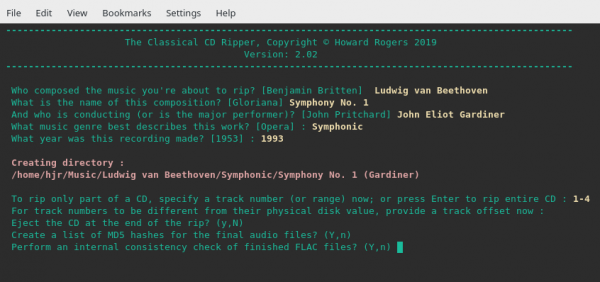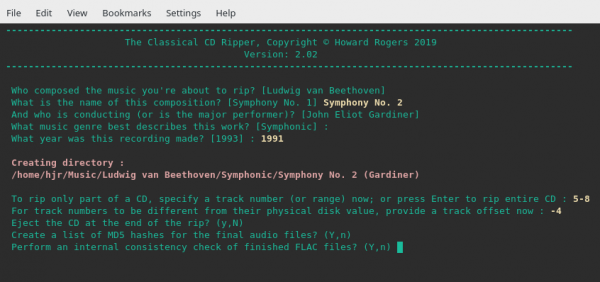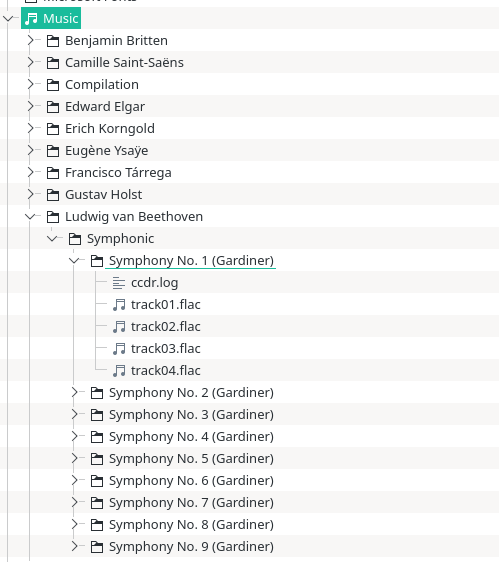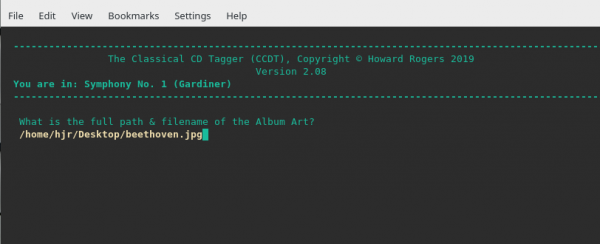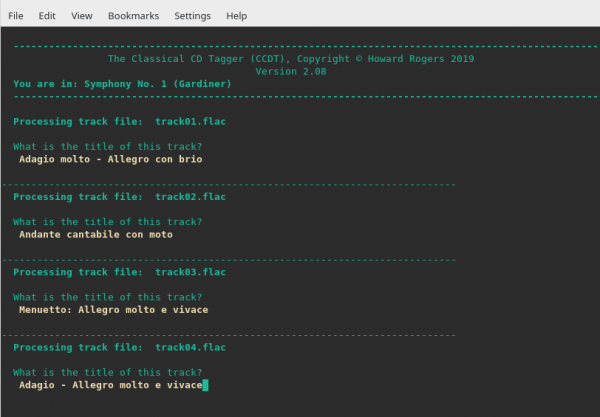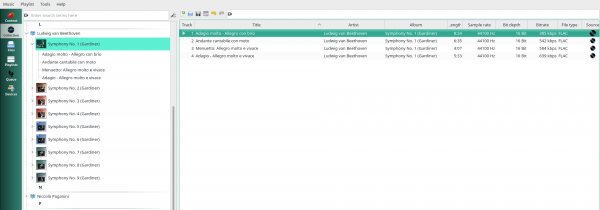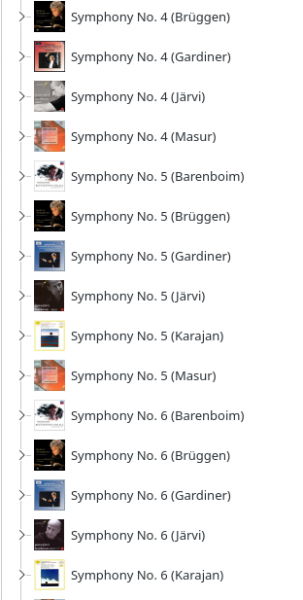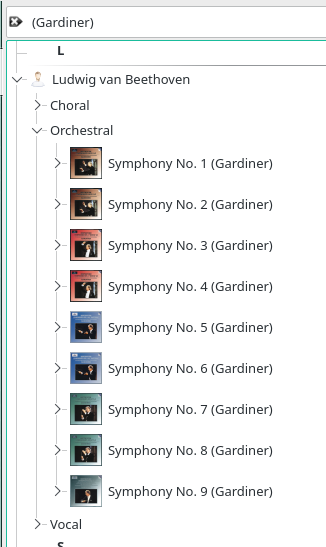1.0 Introduction
This is the last in a series of guides describing how I would suggest you go about the business of ripping and tagging different CDs of varying configurations, on Linux, using my own CCDR and CCDT (Classical CD Ripping and Tagging) tools. Previously, I've discussed ripping various sorts of single disk CDs and two-or-more CD sets. In this final article, I thought I'd specifically address how I would go about ripping this:
This is a boxed set of all John Eliot Gardiner's recordings of the nine Beethoven symphonies. Given that it contains five CDs and Beethoven wrote nine symphonies, we can use this as an exemplar for how you'd go about ripping and tagging any multi-work, multi-CD set of disks.
The specific arrangement of works-and-CDs in this boxed set is as follows:
| CD1 | Tracks 1-4 | Symphony No. 1 |
| Tracks 5-8 | Symphony No. 2 | |
| CD2 | Tracks 1-4 | Symphony No. 3 |
| Tracks 5-8 | Symphony No. 4 | |
| CD3 | Tracks 1-4 | Symphony No. 5 |
| Tracks 5-9 | Symphony No. 6 | |
| CD4 | Tracks 1-4 | Symphony No. 7 |
| Tracks 5-8 | Symphony No. 8 | |
| CD5 | Tracks 1-5 | Symphony No. 9 |
So, although this is presented as a boxed set of a lot of music, it's really just four cases of 2-works-per-CD (which we already covered in a previous article) and one case of 1-work-per-CD (which was covered in the very first article of this series).
Accordingly, since we've covered these exact scenarios in the past, I'm not actually going to go into a lot of detail in this article! The main point here is to realise that, just as Axiom 1 says the physical CD is irrelevant, so you must not get bamboozled into thinking that the boxed set is anything particularly special. It's just a marketing droid's scheme to sell you five CDs in one hit: more money for him and his company, probably less cumulative outlay for you than if you'd bought five separate CDs!
I'd also point out in this regard: Symphony No. 2 in this collection was recorded in 1991 in Blackheath, London; whereas symphonies No. 1 and No. 3 were recorded in the Snape Maltings concert hall in 1993; and Symphony No. 5 had to wait until 1994 and a recording in Barcelona! There is nothing to tie these recordings together, in other words, than the fact that John Eliot Gardiner was the conductor at all times. The recording venues were different; the recording engineers were different. Even the orchestra personnel changed, so that Elizabeth Wilcock was leader of the orchestra in Symphony No. 1, but Peter Hanson filled that role in Symphony No. 4. If you regard this agglomeration of recordings as an aggregated whole, deserving of treatment as a 'cycle' or a work in its own right, you're doing it wrong!
Putting it simply: we have 5 CDs which need to be ripped in exactly the way we've ripped similar 1- and 2-work CDs before. There's nothing special about the fact they were sold to you as a 'boxed set'!
2.0 The Rip
With the fact that we've got 9 separate 'works' that happen to share 5 CDs in mind, let's see how I'd go about doing the rip. Well, the main thing is to take it one CD at a time, since no single symphony splits across 2 CDs. I'd therefore begin by inserting CD1 into my laptop's optical drive, launching CCDR and ripping as follows:
We know from the earlier articles in this series that when there are multiple compositions to be ripped from a single CD, you have to run CCDR multiple times, once for each composition. The trick on each run is to use the track range and track offset settings to control which bits of the CD get ripped where. In this case, I've provided a lot of 'album-wide' information at the top of the screen (most of which we'll be able to re-use on the subsequent CCDR runs, as the composer, principal artist and genre won't be changing for any part of the entire boxed set). In the track-specific bits, I've asked for my first rip to be of tracks 1 to 4, without an offset... so I'll get tracks numbered 1 to 4 on disk, declared to be part of 'Symphony No. 1'.
Once that composition has been ripped successfully, a second run of CCDR looks like this:
As usual, I can just press [Enter] to accept previous runs' answers if they apply to the new run, or type in new information if they're not. So, I'm changing the composition name and recording year, but otherwise all the album-wide metadata still applies and can be accepted without alteration. Crucially, the track selection has now changed to rip the second part of this first CD: tracks 5 to 8 will be ripped, this time with an offset of -4 (so that CD track 5 will become hard disk 1 and so on).
For each subsequent CD in the boxed set, the same sort of 2-part rip will be required: the first of tracks 1 to 4 with no offset; the second of tracks 5 onwards with an offset of -4 each time. The only exception will be the 5th CD, which as Symphony No. 9, occupies an entire CD:
This again should be no surprise: it's an entire CD rip, so the track range is left blank and the track offset is similarly left empty. The only real difference is that at the end of a single CD rip, you can ask for the CD to be ejected, because you won't be needing it for a second run!
The end result of all this CCDR work will be the creation of a series of nine sub-folders, within the Beethoven/Symphonic folders:
Your job is then to visit each of these composition-specific sub-directories in turn and tag the generically-named files with correct album art, performer details and track titles.
3.0 The Tagging
Tagging with the CCDT program has been covered extensively in the other articles in this series: the process is no different now that you have nine compositions to tag up rather than one or two (except that it might take a bit longer, of course!) I don't therefore propose to spend a lot of time explaining the details of how to tag with CDDT now.
But there's one thing I'll mention before I start: when you're tagging these works with artwork, you could use the artwork which represents the boxed set (so it reads 'Beethoven 9 Symphonies' for each symphony). That's fine: it's a visual cue to remind you that you own a boxed set of these works, not individual recordings. But I personally would probably want to tag each symphony with the artwork that was specific to it when it was first released, as a separate recording, not part of a boxed collection. For example, Prestoclassical tells me that the artwork for Symphonies No. 1 and 2 when they were individually released was:
...and I actually prefer that colour and photo of Sir John... so I might choose to obtain that artwork and apply it instead. It would still apply to all eight tracks (i.e., two symphonies) on this particular CD, of course. To take one other example: my complete works of Benjamin Britten came with this artwork:
I would have been certifiably mad to apply that artwork to every single work I ripped from that collection -since, in that case, every single Britten work I catalogued would have looked identical to every other work of his! I would not have been able to tell one from another simply by visual inspection, in other words -and that's a sub-optimal catalogue!
Anyway: the point is, you are free to choose meaningful album artwork. Don't just stick with what's supplied with your particular recording, if that would mislead or provide less information when you're hunting through your library for something to play.
Back to our Beethoven: here's me supplying performer information for the first symphony:
Nothing too complex there: the details are supplied in conductor/orchestra order. Come symphony number 9, of course, I will need to mention the presence of the Monteverdi Choir and the four vocal soloists.
The album art is supplied by, as ever, typing a full path and filename to the relevant JPG or PNG file:
Finally, the track titles are supplied in the usual 'stick to music facts' manner:
As Usual, We Do Not Type In InitCap Mode and we understand musical grammar enough to know to use hyphens to distinguish between the two different tempi used within one movement. There are no movement numbers anywhere to be seen, neither in Roman nor Arabic numeration!
We finish off tagging one symphony by using the 'q' option to quit CCDT cleanly... and then we cd to a new symphony's folder and repeat the process. Second and subsequent runs of CCDT will be able to re-use the performer and album art entries just supplied for Symphony No. 1, though the track titles will have to be typed in manually for each one, of course.
When all nine symphonies are tagged, check them out in the media player of your choice:
You'll note that for that screenshots, I had second thoughts and went back and re-tagged everything with the original artwork for each CD, not the artwork that was applicable to the entire boxed set -but, otherwise, I think you'll find everything is neat, concise, accurate and acceptable.
4.0 Final Thoughts
Summing this up, then: a boxed set is really just a marketing package of individual CDs. Some of those CDs will contain 1 composition; some will contain more than 1 composition; some might only contain a portion of a composition. Either way, you treat each composition as being 'king' and handle the CDs accordingly. In this particular case, 4 CDs just got ripped in the same manner as '1 CD containing 2 works'; and 1 CD got ripped as '1 CD containing 1 work' -both scenarios we've met before.
The objection to this approach, I think, is probably that you lose the sense of the entire set of symphonies belonging to one boxed set (which might be an important thing some people want to remember and be reminded of, though personally I don't). Using a piece of album art that is common to the complete set can help here; making sure your "distinguishing artist" is clearly distinguishable in the ALBUM tag is another thing that can help.
Fundamentally, it is true however that when you have multiple boxed sets, if you tag in the way I have just shown, you will end up with them being 'dispersed':
That is, all my Beethoven Symphony No. 4s get listed together before my Symphony No. 5s and my Symphony No. 6s, and so on: the net result is that the component parts of Gardiner's 'cycle' are no longer 'adjacent' to each other. His recordings now don't appear as a contiguous listing, because the distinguishing artist name is at the end of the album name tag. For me, this isn't an issue: as I tried to explain at the start of this article, Gardiner recorded these symphonies over a period of about three years, in different places and with different players making up the orchestra. There's nothing to really link them together in such an intimate way, to my mind, as to warrant listing them together as if they were part of a whole. It's the individual symphonies that matter to me, so I prefer to see them organised appropriately, rather than their conductors. So the 'dispersed' listing you see above, to my mind, merely reflects a more important reality than caring about who's conducting each of them.
Remember, too, that your media player should be competent enough to have a decent search engine. If I, with my album names as shown above, nevertheless wanted to see all of Gardiner's recordings as a single, contiguous entity, I can do so simply by searching for recordings made by Gardiner, causing all my non-Gardiner recordings to be filtered out:
A lot of the bad tagging practices I see being advocated by well-meaning people from time to time mostly arise from the fact that they appear to have forgotten that a good digital media player will be able to filter and search or can group and display things by non-default tag arrangements. Using those tools and functionalities, I therefore can achieve a contiguous listing, despite it not being my player's default way of listing things. I don't need to change my tagging habits to achieve the desired outcome, basically.
But if you really, really wanted your Gardiner cycle symphonies all listed together by default, followed by all your Järvi cycle symphonies and then your Karajan cycle symphonies, you could achieve that just by putting your distinguishing artist at the front of your ALBUM tag. Personally, I would hate to see "(Gardiner) Symphony No. 1", "(Gardiner) Symphony No. 2" and so on in my own listings, because to my mind that appears to want to make the conductor more important than the work he's conducting. But if that grouping is what's important to you, and you don't want to have to exploit your player's less-well-advertised features to achieve it, or your media player doesn't have such capabilities in the first place... well, it's easily do-able simply by adjusting the word-order rules of the ALBUM tag very slightly, without changing the fundamental principles of the overall tagging game.
Back to the Master Index of the Guides to Ripping and Tagging

